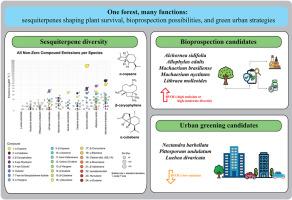揭示巴西大西洋森林残余的优势树木的倍半萜排放
IF 3.4
Q2 ENVIRONMENTAL SCIENCES
引用次数: 0
摘要
尽管大西洋森林具有重要意义,但人们对其树种的生物源性挥发性有机化合物(BVOC)排放知之甚少。本研究旨在利用动态封闭系统和气相色谱-质谱联用技术(GC-MS)对巴西圣保罗附近森林遗迹中10种优势种的倍半萜(SQT)排放进行表征。共注释了24个sqt,包括7个氧合倍半萜(osqt)。排放范围从Luehea divaricata中检测不到到Alchornea sidifolia中的277.54 ng gDM−1 h−1。分层聚类根据排放强度和化学多样性将物种分为4类:(1)低化学多样性的高排放(A. sidifolia),(2)高多样性的中高排放(brasiliense和Allophylus edulis),(3)低多样性(Guarea macrophylla)至中等多样性(Machaerium nyctitans, Lithraea molleoides和Casearia sylvestris)的中排放,以及(4)低排放低(Pittosporum波动)至中等多样性(Nectandra barbellata)或无法检测到的排放(Luehea divaricata)。大多数物种主要释放α-copaene、β-石竹烯或α-立方烯,它们都具有防御/生态功能,如食草动物威慑和抗菌活性。具有高β-石竹烯排放量的物种(A. edulis, L. molleoides)或OSQT多样性的物种(A. sidifolia, M. brasiliense, M. nyctitans)成为生物勘探的有希望的候选物种。相反,从sqt排放的角度来看,低排放物种(N. barbellata, P. undulatum和L. divaricata)由于对二次污染物形成的贡献有限,因此代表了城市绿化的合适潜在候选者。这些发现为今后大西洋森林BVOC的研究奠定了基础,并为基于其SQT排放特征的物种战略选择和应用提供了支持。本文章由计算机程序翻译,如有差异,请以英文原文为准。

Unveiling sesquiterpene emissions in dominant trees of a Brazilian Atlantic Forest remnant
Despite the significance of the Atlantic Forest, little is known about the biogenic volatile organic compound (BVOC) emissions from its tree species. This study aimed to characterize sesquiterpene (SQT) emissions from ten dominant species in a forest remnant near São Paulo, Brazil, using a dynamic enclosure system and gas chromatography–mass spectrometry (GC-MS). A total of 24 SQTs were annotated, including seven oxygenated sesquiterpenes (OSQTs). Emissions ranged from undetectable in Luehea divaricata to 277.54 ng gDM−1 h−1 in Alchornea sidifolia. Hierarchical clustering grouped species into four clusters based on emission intensity and chemical diversity: (1) high emission with low chemical diversity (A. sidifolia), (2) moderate-to-high emission with high diversity (Machaerium brasiliense and Allophylus edulis), (3) moderate emission with low (Guarea macrophylla) to moderate diversity (Machaerium nyctitans, Lithraea molleoides, and Casearia sylvestris), and (4) low emissions and low (Pittosporum undulatum) to moderate diversity (Nectandra barbellata), or undetectable emissions (Luehea divaricata). Most species predominantly emitted α-copaene, β-caryophyllene, or α-cubebene, each linked to defensive/ecological functions like herbivore deterrence and antimicrobial activity. Species with high β-caryophyllene emissions (A. edulis, L. molleoides) or OSQT diversity (A. sidifolia, M. brasiliense, M. nyctitans) emerged as promising candidates for bioprospecting. Conversely, from a SQT-emission perspective, low-emitting species (N. barbellata, P. undulatum, and L. divaricata) represent suitable potential candidates for urban greening due to their limited contribution to secondary pollutant formation. These findings provide a foundation for future BVOC research in the Atlantic Forest and support the strategic selection and application of species based on their SQT emission profiles.
求助全文
通过发布文献求助,成功后即可免费获取论文全文。
去求助
来源期刊

Atmospheric Environment: X
Environmental Science-Environmental Science (all)
CiteScore
8.00
自引率
0.00%
发文量
47
审稿时长
12 weeks
 求助内容:
求助内容: 应助结果提醒方式:
应助结果提醒方式:


